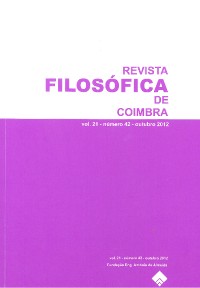Please use this identifier to cite or link to this item:
https://hdl.handle.net/10316.2/29407| Title: | Hegel, Escher, Borges: figuras e conceitos da reflexão | Authors: | Ferrer, Diogo | Keywords: | G. W. F. Hegel;M. C. Escher;J. L. Borges;Representation;Self‑Reference;Subjectivity;Reflection;Negative;Consciousness;Self‑consciousness;Self‑representation;Contradiction;G. W. F. Hegel;M. C. Escher;J. L. Borges;Representação;Auto‑Referência;Subjectividade;Reflexão;Negativo;Consciência;Auto‑Consciência;Figuração;Contradição | Issue Date: | 2012 | Publisher: | Faculdade de Letras da Universidade de Coimbra, Instituto de Estudos Filosóficos | Abstract: | Este artigo apresenta um estudo comparativo entre o pensamento
de G. W. F. Hegel, a arte gráfica de M. C. Escher e a literatura fantástica de J. L.
Borges. Nestes três autores, um mesmo tema essencial é mostrado em imagens,
contado em linguagem literária e pensado em conceitos. Este tema essencial são
as condições da figuração ou da representação dos conteúdos na arte e no pensamento.
Nos três autores, trata‑se
de expor, em diferentes linguagens, o próprio
acto de figurar em geral, visual, literária ou conceptualmente.
O estudo comparativo revela preocupações e respostas similares, nomeadamente
quanto aos seguintes tópicos, entre outros: o questionamento explícito
da relação entre forma e fundo como condição básica tanto da figuração
visual quanto da expressão conceptual; uma especial atenção à consciência e à
auto‑consciência
como supostos necessários de toda a representação; o papel da
negação e da negatividade na relação entre ser e imagem; o significado teórico
das representações auto‑referentes
e cíclicas; a construção de representações
incongruentes ou contraditórias pela exposição sistematicamente regulada, numa
mesma representação, de pontos de vista visual ou conceptualmente opostos e
incompatíveis entre si. This paper presents a comparative study between the philosophical thought of G. W. F. Hegel, the graphic art of M. C. Escher and the fantastic literature of J. L. Borges. In the three authors, one common subject is shown in images, told in literary language and thought in concepts. The main topic studied in the three authors is the conditions of representation, or of picturing contents in art and thought. In all these authors we find the representation of the very act of picturing, under visual, literary and philosophical conditions. The comparative study shows similar questions and answers regarding the following topics: an explicit questioning about the relation between form and background, as the basic condition for both visual and conceptual expression; an attention to consciousness and self‑consciousness as necessary conditions for any representation; the role played by negation and negativity in the explanation of the relation between being and image; the importance of cyclic and self‑referential representations; the construction of incongruent or contradictory representations by a systematic and regulated exposition, in the same representation, of visually and conceptually opposing and conflicting points of view. |
URI: | https://hdl.handle.net/10316.2/29407 | ISSN: | 0872-0851 | DOI: | 10.14195/0872-0851_42_2 |
| Appears in Collections: | Revista Filosófica de Coimbra |
Files in This Item:
| File | Description | Size | Format | |
|---|---|---|---|---|
| rfc42_artigo3.pdf | 5.12 MB | Adobe PDF |  |
Items in DSpace are protected by copyright, with all rights reserved, unless otherwise indicated.
